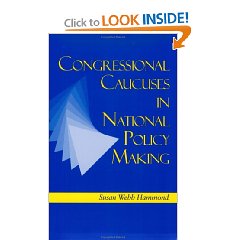The author's bottom line, based on original research and a fine overview of national, regional, state/district, industry, party, and personal interest caucuses, is that they provide a very substantial *complement* to the formal committee process, and thus render an invaluable service to Members.
Caucuses, in the author's investigative report, exist primarily to help Members deal with complex issues that are either multi-jurisdictional in nature, not covered adequately by existing Committee assignments, or lacking in political support or attention for various reasons–the High Altitude Caucus, to keep environmental regulations designed for sea-level from being too silly at high altitudes, is a good example of the latter.
Caucuses are primarily information collection and sharing vehicles, followed by agenda and policy setting tools. They serve as valuable forums for orienting new Members or helping Members across various Committee jurisdictions focus on shared concerns.
The book finds that caucuses are perceived as policy actors, both within the legislative process and within the Administration. In the 100th Congress, the focal point for the book, most caucuses were focused on economic issues, especially trade. About a quarter focused on defense and foreign policy including international trade and immigration issues. Roughly 20% worked trade issues, 17% defense issues, and 13% immigration, human rights, and terrorism issues.
At the time of the book's writing there were no caucuses on national information strategy or information technology applications relevant to improving government operations at the federal level, or between the federal and state/local levels.
Administratively, in the past caucuses could be recognized as legislative service agencies and given official funding and floor space. These privileges were eliminated in the mid-1990's due to leadership concerns over accountability and propriety. Some converted to non-profit status, others to a new form of caucus, the congressional member organization. In the aftermath of the 104th Congress elimination of the older form of caucus, most have staffs that are very small, 1-2 at most, and tend to be managed by the leading Member.
This is a fine book and a good first start for what could be a new literature on new forms of democratic representation enabled by the Internet. There is no reason why the emerging trends in cyber-advocacy and digital democracy at described so well by the Foundation on Public Affairs might not eventually be integrated into a larger digital caucus environment in which Members can matrix various grassroots civic offerings, industry information, and caucus-based filtering and analytic services, to get in closer touch with real-world information that is not filtered by the Administration or the constrained by the limitations of the Congressional Research Service, which does the best it can with excruciatingly limited resources. I hope the author goes on to write this second book as her first is a valuable and helpful offering to policy-makers, citizen advocates, and students of the emerging new democratic processes made possible by the Internet.





